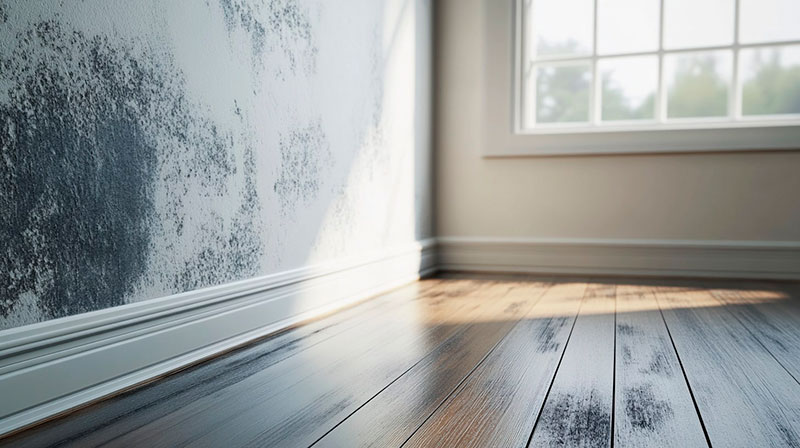WINTER SPECIAL: Buy now, get one free ⛄️ Conditions apply. Get free quote
WINTER SPECIAL: Buy now, get one free ⛄️ Conditions apply. Get free quote

Author:
Condensation on windows is a common challenge for many homeowners, especially in Canada’s diverse climate. Left unaddressed, it can lead to aesthetic concerns, health risks, and potential damage to your property. As a trusted GTA-based manufacturer, Total Home Windows and Doors understands the need for practical and effective solutions. This article explores the causes, prevention, and management of moisture on windows, ensuring your home remains comfortable, healthy, and energy-efficient.
Condensation occurs when warm, moist air comes into contact with a cold surface, such as window glass, causing water vapour to condense into liquid droplets. This phenomenon occurs when warm, moist air contacts a colder surface, leading to moisture release on the surfaces as droplets. This phenomenon, often noticeable during colder months, can result from:
Ignoring window condensation can lead to:
As Anna Klein, COO of Total Home Windows and Doors, explains: “Proactively managing condensation not only preserves your windows but also enhances your home’s air quality and overall comfort.”
The root causes of condensation lie in the interaction between humidity, temperature, and ventilation.
Condensation forms when moist air meets a cooler surface. This often occurs when indoor humidity levels are high, and the dew point (the temperature at which water vapour condenses) is reached.
| Condensation Type | Causes | Signs | Implications | Solutions |
| Interior window condensation | Excessive indoor humidity, insufficient ventilation, and cold window surfaces | Morning condensation on bedroom windows, fogged windows during colder months | Encourages mould growth, damages window frames | Improve ventilation, reduce moisture using a dehumidifier, ensure consistent heating |
| Exterior window condensation | Cool outdoor air cooling the window's exterior surface | Common in newer energy-efficient windows, more frequent during spring and autumn | Generally harmless, but can obscure views | No action usually required, ensure exterior is clean |
| Condensation between panes | Failed seals in double-glazed windows | Persistent fogging or water droplets within glass layers | Reduces energy efficiency, requires repair | Replace the sealed unit or the entire window if needed |

Improving air circulation is essential to reduce condensation on windows. When warm, moist air is trapped inside a room, it can lead to condensation on the window glass. Here are some effective ways to enhance air circulation in your home:
By implementing these strategies, you can significantly reduce the likelihood of condensation forming on your windows, ensuring a more comfortable and healthier living environment.
Reducing humidity is crucial to preventing condensation on windows. High humidity levels can lead to excess moisture in the air, which then condenses on cold surfaces like window glass. Here are some effective ways to manage and reduce indoor humidity:
By taking these steps to reduce humidity, you can minimize the risk of condensation forming on your windows, protecting your home from potential damage and maintaining a healthier indoor environment.
Maintaining windows is essential to preventing condensation and ensuring their longevity. Regular upkeep can help to keep your windows in top condition and reduce the likelihood of condensation issues. Here are some maintenance tips to consider:
By following these maintenance tips, you can keep your windows in excellent condition, reduce condensation, and enhance the overall comfort and energy efficiency of your home.

Persistent moisture leads to black mould, which is unsightly and poses health risks.
As Vitaly Shapiro, VP of Sales, notes: “Proper ventilation and high-quality windows are the first lines of defence against condensation and mould.”
As Alexandr Naumov, Project Manager, advises:
“Replacing older windows with energy-efficient models can significantly reduce condensation issues and improve your home’s overall comfort.”
Managing window condensation is essential for preserving your home’s integrity and ensuring a healthy living environment. By understanding the causes and implementing effective solutions, you can maintain clear, condensation-free windows throughout the year. Whether it’s through simple fixes or professional upgrades, the benefits are worth the effort.
At Total Home Windows and Doors, we’re committed to helping you achieve a comfortable, energy-efficient home. Reach out today to learn more about our energy-efficient windows and other solutions or Canadian homeowners.
Condensation on the inside occurs when warm, moist air from indoor activities meets a cold window surface. High indoor humidity and poor ventilation are primary factors.
Exterior condensation forms when cool air meets a window’s warm exterior surface, typically in humid or cooler seasons. This is common with energy-efficient windows and does not indicate a problem.
Older windows often lack insulation, making them prone to condensation. Installing double glazing or upgrading to newer, insulated models can help.
Initially, new windows may trap excessive humidity due to their improved seals. Proper ventilation helps balance humidity levels.
Cold outside temperatures increase the likelihood of condensation as warm indoor air meets a cold glass surface.
Condensation between glass panes suggests a seal failure in double- or triple-glazed windows. Professional repairs or replacements may be required.
Highly energy-efficient windows can sometimes show condensation due to their tight seals, but this usually indicates high indoor humidity rather than a window defect.
Yes, ceiling fans improve air circulation, reducing pockets of moist air that could lead to condensation.

Total Home in Ontario is a leading provider of professional and high-quality services on windows & doors supply and installation.
We aim to achieve ultimate customer satisfaction and ensure your home renovation and improvement project would become a positive experience.
Head Office & Showroom
7250 Keele street, Unit 167,
Vaughan, ON. L4K 1Z8
Phone: 416-661-6666
Toll Free: 1-855-550-0610
We work together as a team with a common goal:
* Per household | cannot be combined with any other offer | not applicable for basement windows | minimum window size of 9 square feet | applicable only for energy efficient models
Copyright 2024 TH Windows and Doors Toronto | All Rights Reserved | Made in SEORepublic.com